Annotation of Assessing Reading
VerifiedAdded on 2022/08/31
|15
|4270
|28
AI Summary
Contribute Materials
Your contribution can guide someone’s learning journey. Share your
documents today.
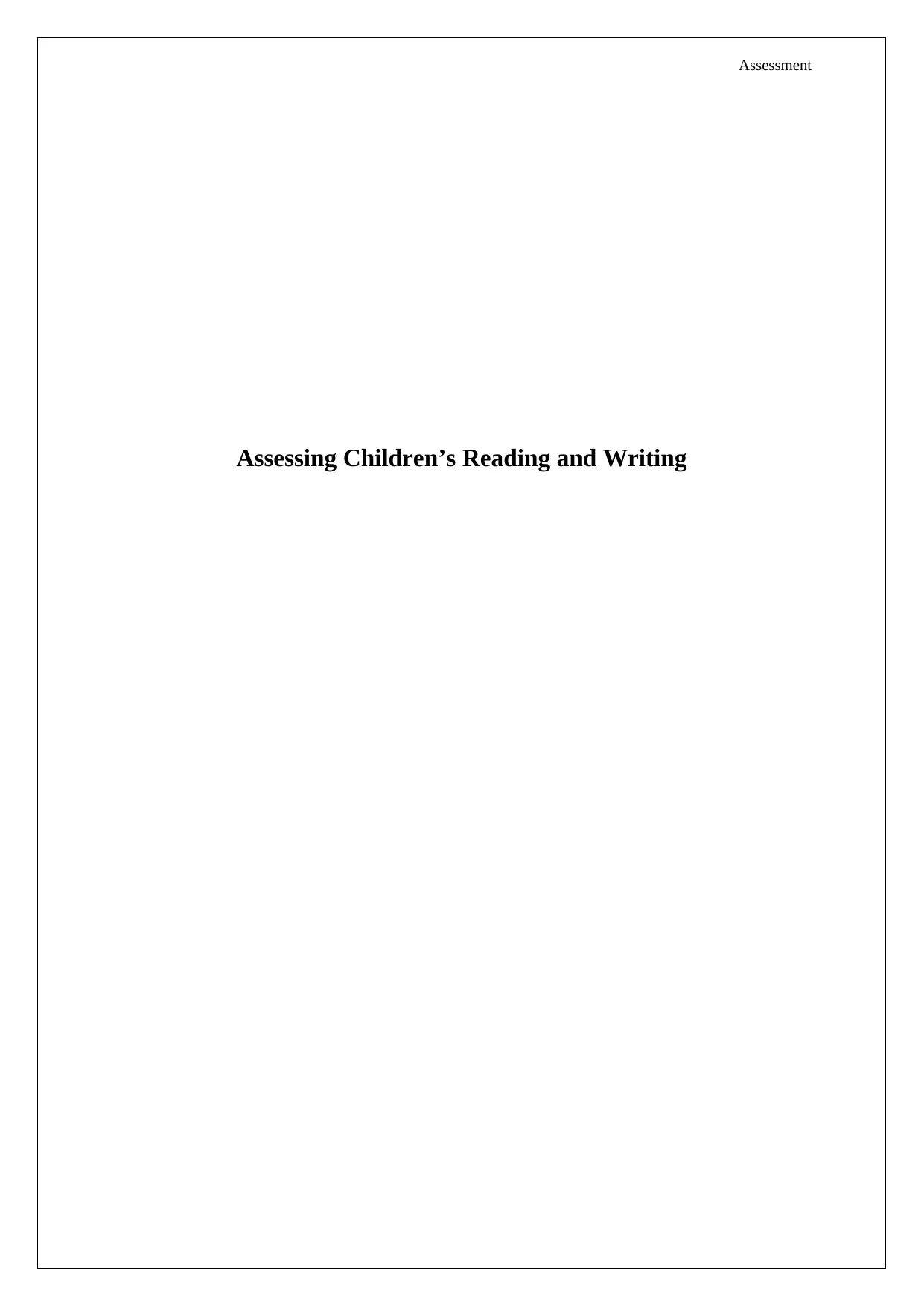
Assessment
Assessing Children’s Reading and Writing
Assessing Children’s Reading and Writing
Secure Best Marks with AI Grader
Need help grading? Try our AI Grader for instant feedback on your assignments.
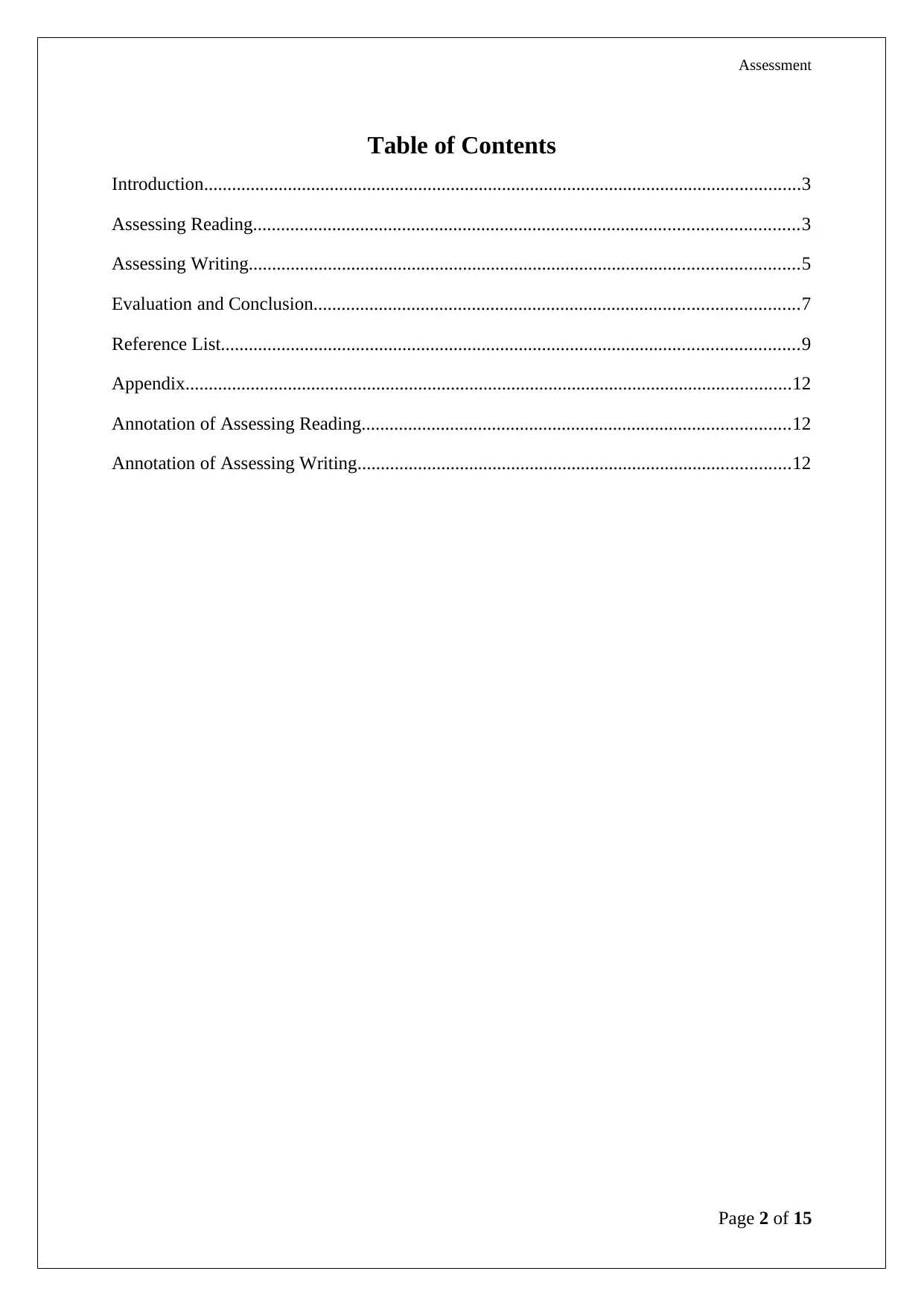
Assessment
Table of Contents
Introduction................................................................................................................................3
Assessing Reading.....................................................................................................................3
Assessing Writing......................................................................................................................5
Evaluation and Conclusion........................................................................................................7
Reference List............................................................................................................................9
Appendix..................................................................................................................................12
Annotation of Assessing Reading............................................................................................12
Annotation of Assessing Writing.............................................................................................12
Page 2 of 15
Table of Contents
Introduction................................................................................................................................3
Assessing Reading.....................................................................................................................3
Assessing Writing......................................................................................................................5
Evaluation and Conclusion........................................................................................................7
Reference List............................................................................................................................9
Appendix..................................................................................................................................12
Annotation of Assessing Reading............................................................................................12
Annotation of Assessing Writing.............................................................................................12
Page 2 of 15

Assessment
Introduction
Reading and decoding can be termed as one of the most important qualities during the initial
stages of development. Year 1 child does not speak English as a first language. However, can
speak the language, with grammar mistakes, the assignment thus aims to analyze the reading
and writing skills of the child with suitable techniques. The work additionally aims to find
possible areas of improvement. As influenced by Perfetti (2017), few kids are naturally
strategic readers. However, most kids lack the mentioned ability. Thus, the work analyses the
potential to ensure better prospects of English understanding in the child.
Assessing Reading
The act of decoding the text is of prime importance (Rothouand Tsimpli, 2017). The chosen
story of Jack and the Beanstalk is highly interactive. Thus, the study in the mentioned context
the child is allowed to read from the story, which contains several pictures. The first picture is
composed of beans, which resemble seeds. The child immediately points out at the seeds and
relates it to trees. The first instance can be termed as a successful step as the concept of
beanstalk would be easier for the child to understand. The conversation is kept concise and
focused (Gamble, Nikki, 2013). The reader should read slowly to keep the child engaged and
interested in the activity (Clayton et al. 2017). In similar regards, it becomes important to
restate the statement to the child to make sure that no information is missed out. Thus, it
becomes important to understand the fact that the child needs to be trained in case he or she
misses out something important.
The mentioned intervention of decoding additionally works on understanding the current
prospects related to the image (Waugh, 2015). The image represents a boy trying to climb a
plant. The mention of Jack several times was a hint that the child could easily relate the name
with the person. The long plant is an actual result of the seeds planted is an easy method to
ensure that the student establishes a link between the plant and the plan of the beanstalk.
Teaching strategies during the lesson is important. That way the teacher exposes the student
to the activity of decoding the text can help the student informing effective strategies for
future reading prospects. As influenced by Swagerman et al. (2017), teachers prefer to teach
in small groups and that can be termed as a leading way of incorporating an important skill.
At the end of the class, the student should be encouraged to take up independent reading. The
aspect of independent reading can be followed up by with guided practice and modeling. The
use of visuals for teaching can be termed as one of the leading ways to ensure that the child
Page 3 of 15
Introduction
Reading and decoding can be termed as one of the most important qualities during the initial
stages of development. Year 1 child does not speak English as a first language. However, can
speak the language, with grammar mistakes, the assignment thus aims to analyze the reading
and writing skills of the child with suitable techniques. The work additionally aims to find
possible areas of improvement. As influenced by Perfetti (2017), few kids are naturally
strategic readers. However, most kids lack the mentioned ability. Thus, the work analyses the
potential to ensure better prospects of English understanding in the child.
Assessing Reading
The act of decoding the text is of prime importance (Rothouand Tsimpli, 2017). The chosen
story of Jack and the Beanstalk is highly interactive. Thus, the study in the mentioned context
the child is allowed to read from the story, which contains several pictures. The first picture is
composed of beans, which resemble seeds. The child immediately points out at the seeds and
relates it to trees. The first instance can be termed as a successful step as the concept of
beanstalk would be easier for the child to understand. The conversation is kept concise and
focused (Gamble, Nikki, 2013). The reader should read slowly to keep the child engaged and
interested in the activity (Clayton et al. 2017). In similar regards, it becomes important to
restate the statement to the child to make sure that no information is missed out. Thus, it
becomes important to understand the fact that the child needs to be trained in case he or she
misses out something important.
The mentioned intervention of decoding additionally works on understanding the current
prospects related to the image (Waugh, 2015). The image represents a boy trying to climb a
plant. The mention of Jack several times was a hint that the child could easily relate the name
with the person. The long plant is an actual result of the seeds planted is an easy method to
ensure that the student establishes a link between the plant and the plan of the beanstalk.
Teaching strategies during the lesson is important. That way the teacher exposes the student
to the activity of decoding the text can help the student informing effective strategies for
future reading prospects. As influenced by Swagerman et al. (2017), teachers prefer to teach
in small groups and that can be termed as a leading way of incorporating an important skill.
At the end of the class, the student should be encouraged to take up independent reading. The
aspect of independent reading can be followed up by with guided practice and modeling. The
use of visuals for teaching can be termed as one of the leading ways to ensure that the child
Page 3 of 15
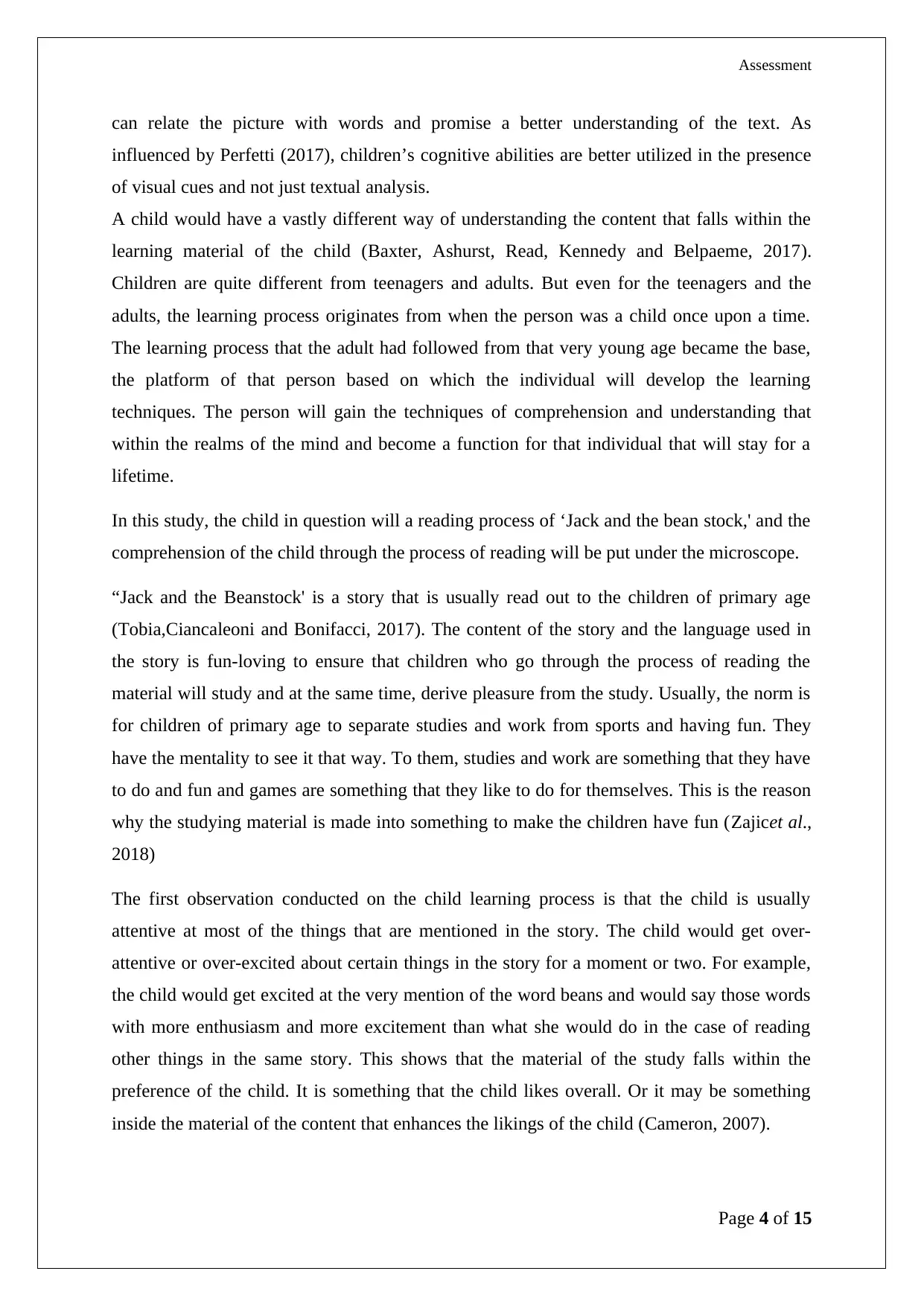
Assessment
can relate the picture with words and promise a better understanding of the text. As
influenced by Perfetti (2017), children’s cognitive abilities are better utilized in the presence
of visual cues and not just textual analysis.
A child would have a vastly different way of understanding the content that falls within the
learning material of the child (Baxter, Ashurst, Read, Kennedy and Belpaeme, 2017).
Children are quite different from teenagers and adults. But even for the teenagers and the
adults, the learning process originates from when the person was a child once upon a time.
The learning process that the adult had followed from that very young age became the base,
the platform of that person based on which the individual will develop the learning
techniques. The person will gain the techniques of comprehension and understanding that
within the realms of the mind and become a function for that individual that will stay for a
lifetime.
In this study, the child in question will a reading process of ‘Jack and the bean stock,' and the
comprehension of the child through the process of reading will be put under the microscope.
“Jack and the Beanstock' is a story that is usually read out to the children of primary age
(Tobia,Ciancaleoni and Bonifacci, 2017). The content of the story and the language used in
the story is fun-loving to ensure that children who go through the process of reading the
material will study and at the same time, derive pleasure from the study. Usually, the norm is
for children of primary age to separate studies and work from sports and having fun. They
have the mentality to see it that way. To them, studies and work are something that they have
to do and fun and games are something that they like to do for themselves. This is the reason
why the studying material is made into something to make the children have fun (Zajicet al.,
2018)
The first observation conducted on the child learning process is that the child is usually
attentive at most of the things that are mentioned in the story. The child would get over-
attentive or over-excited about certain things in the story for a moment or two. For example,
the child would get excited at the very mention of the word beans and would say those words
with more enthusiasm and more excitement than what she would do in the case of reading
other things in the same story. This shows that the material of the study falls within the
preference of the child. It is something that the child likes overall. Or it may be something
inside the material of the content that enhances the likings of the child (Cameron, 2007).
Page 4 of 15
can relate the picture with words and promise a better understanding of the text. As
influenced by Perfetti (2017), children’s cognitive abilities are better utilized in the presence
of visual cues and not just textual analysis.
A child would have a vastly different way of understanding the content that falls within the
learning material of the child (Baxter, Ashurst, Read, Kennedy and Belpaeme, 2017).
Children are quite different from teenagers and adults. But even for the teenagers and the
adults, the learning process originates from when the person was a child once upon a time.
The learning process that the adult had followed from that very young age became the base,
the platform of that person based on which the individual will develop the learning
techniques. The person will gain the techniques of comprehension and understanding that
within the realms of the mind and become a function for that individual that will stay for a
lifetime.
In this study, the child in question will a reading process of ‘Jack and the bean stock,' and the
comprehension of the child through the process of reading will be put under the microscope.
“Jack and the Beanstock' is a story that is usually read out to the children of primary age
(Tobia,Ciancaleoni and Bonifacci, 2017). The content of the story and the language used in
the story is fun-loving to ensure that children who go through the process of reading the
material will study and at the same time, derive pleasure from the study. Usually, the norm is
for children of primary age to separate studies and work from sports and having fun. They
have the mentality to see it that way. To them, studies and work are something that they have
to do and fun and games are something that they like to do for themselves. This is the reason
why the studying material is made into something to make the children have fun (Zajicet al.,
2018)
The first observation conducted on the child learning process is that the child is usually
attentive at most of the things that are mentioned in the story. The child would get over-
attentive or over-excited about certain things in the story for a moment or two. For example,
the child would get excited at the very mention of the word beans and would say those words
with more enthusiasm and more excitement than what she would do in the case of reading
other things in the same story. This shows that the material of the study falls within the
preference of the child. It is something that the child likes overall. Or it may be something
inside the material of the content that enhances the likings of the child (Cameron, 2007).
Page 4 of 15
Secure Best Marks with AI Grader
Need help grading? Try our AI Grader for instant feedback on your assignments.
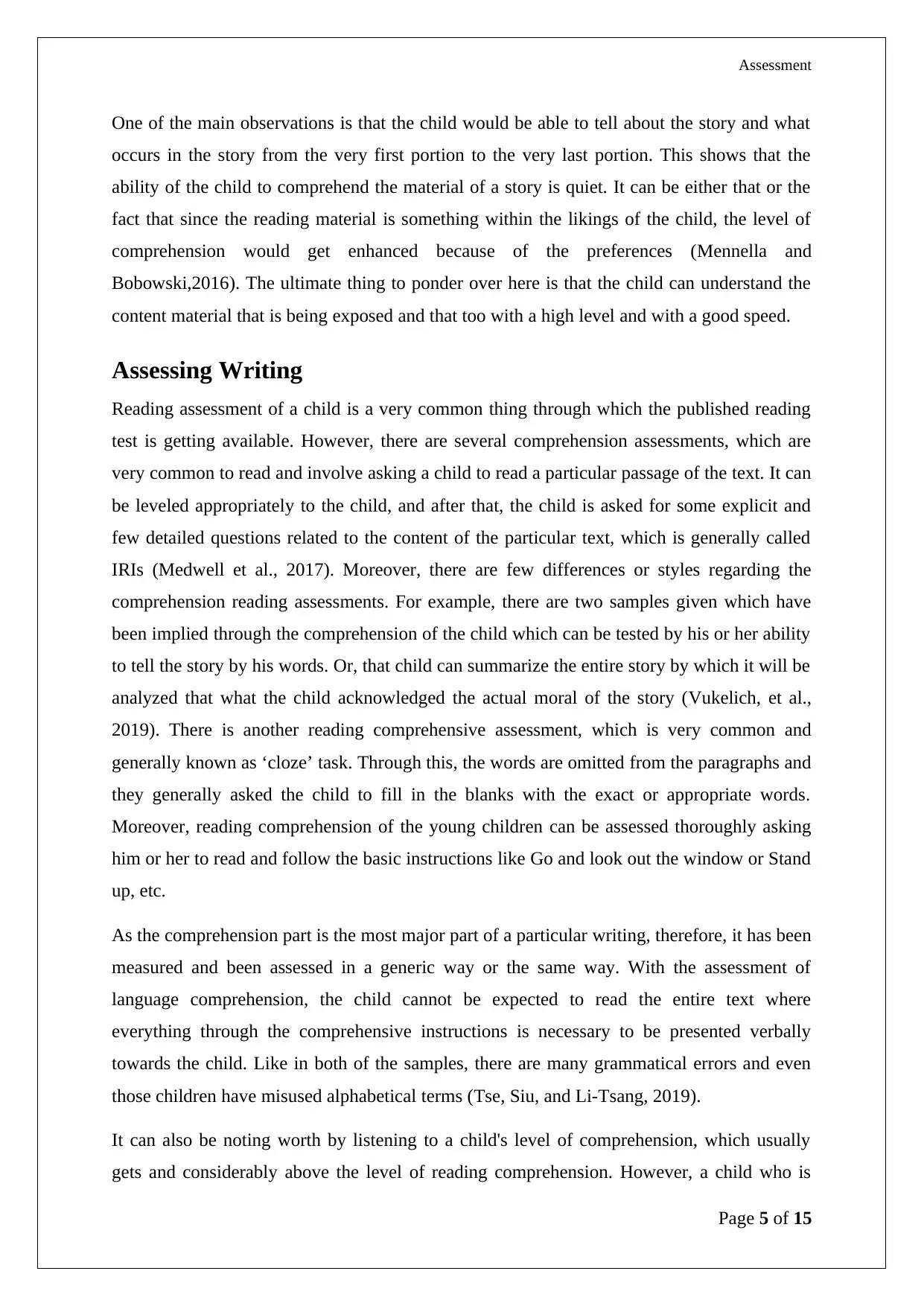
Assessment
One of the main observations is that the child would be able to tell about the story and what
occurs in the story from the very first portion to the very last portion. This shows that the
ability of the child to comprehend the material of a story is quiet. It can be either that or the
fact that since the reading material is something within the likings of the child, the level of
comprehension would get enhanced because of the preferences (Mennella and
Bobowski,2016). The ultimate thing to ponder over here is that the child can understand the
content material that is being exposed and that too with a high level and with a good speed.
Assessing Writing
Reading assessment of a child is a very common thing through which the published reading
test is getting available. However, there are several comprehension assessments, which are
very common to read and involve asking a child to read a particular passage of the text. It can
be leveled appropriately to the child, and after that, the child is asked for some explicit and
few detailed questions related to the content of the particular text, which is generally called
IRIs (Medwell et al., 2017). Moreover, there are few differences or styles regarding the
comprehension reading assessments. For example, there are two samples given which have
been implied through the comprehension of the child which can be tested by his or her ability
to tell the story by his words. Or, that child can summarize the entire story by which it will be
analyzed that what the child acknowledged the actual moral of the story (Vukelich, et al.,
2019). There is another reading comprehensive assessment, which is very common and
generally known as ‘cloze’ task. Through this, the words are omitted from the paragraphs and
they generally asked the child to fill in the blanks with the exact or appropriate words.
Moreover, reading comprehension of the young children can be assessed thoroughly asking
him or her to read and follow the basic instructions like Go and look out the window or Stand
up, etc.
As the comprehension part is the most major part of a particular writing, therefore, it has been
measured and been assessed in a generic way or the same way. With the assessment of
language comprehension, the child cannot be expected to read the entire text where
everything through the comprehensive instructions is necessary to be presented verbally
towards the child. Like in both of the samples, there are many grammatical errors and even
those children have misused alphabetical terms (Tse, Siu, and Li-Tsang, 2019).
It can also be noting worth by listening to a child's level of comprehension, which usually
gets and considerably above the level of reading comprehension. However, a child who is
Page 5 of 15
One of the main observations is that the child would be able to tell about the story and what
occurs in the story from the very first portion to the very last portion. This shows that the
ability of the child to comprehend the material of a story is quiet. It can be either that or the
fact that since the reading material is something within the likings of the child, the level of
comprehension would get enhanced because of the preferences (Mennella and
Bobowski,2016). The ultimate thing to ponder over here is that the child can understand the
content material that is being exposed and that too with a high level and with a good speed.
Assessing Writing
Reading assessment of a child is a very common thing through which the published reading
test is getting available. However, there are several comprehension assessments, which are
very common to read and involve asking a child to read a particular passage of the text. It can
be leveled appropriately to the child, and after that, the child is asked for some explicit and
few detailed questions related to the content of the particular text, which is generally called
IRIs (Medwell et al., 2017). Moreover, there are few differences or styles regarding the
comprehension reading assessments. For example, there are two samples given which have
been implied through the comprehension of the child which can be tested by his or her ability
to tell the story by his words. Or, that child can summarize the entire story by which it will be
analyzed that what the child acknowledged the actual moral of the story (Vukelich, et al.,
2019). There is another reading comprehensive assessment, which is very common and
generally known as ‘cloze’ task. Through this, the words are omitted from the paragraphs and
they generally asked the child to fill in the blanks with the exact or appropriate words.
Moreover, reading comprehension of the young children can be assessed thoroughly asking
him or her to read and follow the basic instructions like Go and look out the window or Stand
up, etc.
As the comprehension part is the most major part of a particular writing, therefore, it has been
measured and been assessed in a generic way or the same way. With the assessment of
language comprehension, the child cannot be expected to read the entire text where
everything through the comprehensive instructions is necessary to be presented verbally
towards the child. Like in both of the samples, there are many grammatical errors and even
those children have misused alphabetical terms (Tse, Siu, and Li-Tsang, 2019).
It can also be noting worth by listening to a child's level of comprehension, which usually
gets and considerably above the level of reading comprehension. However, a child who is
Page 5 of 15
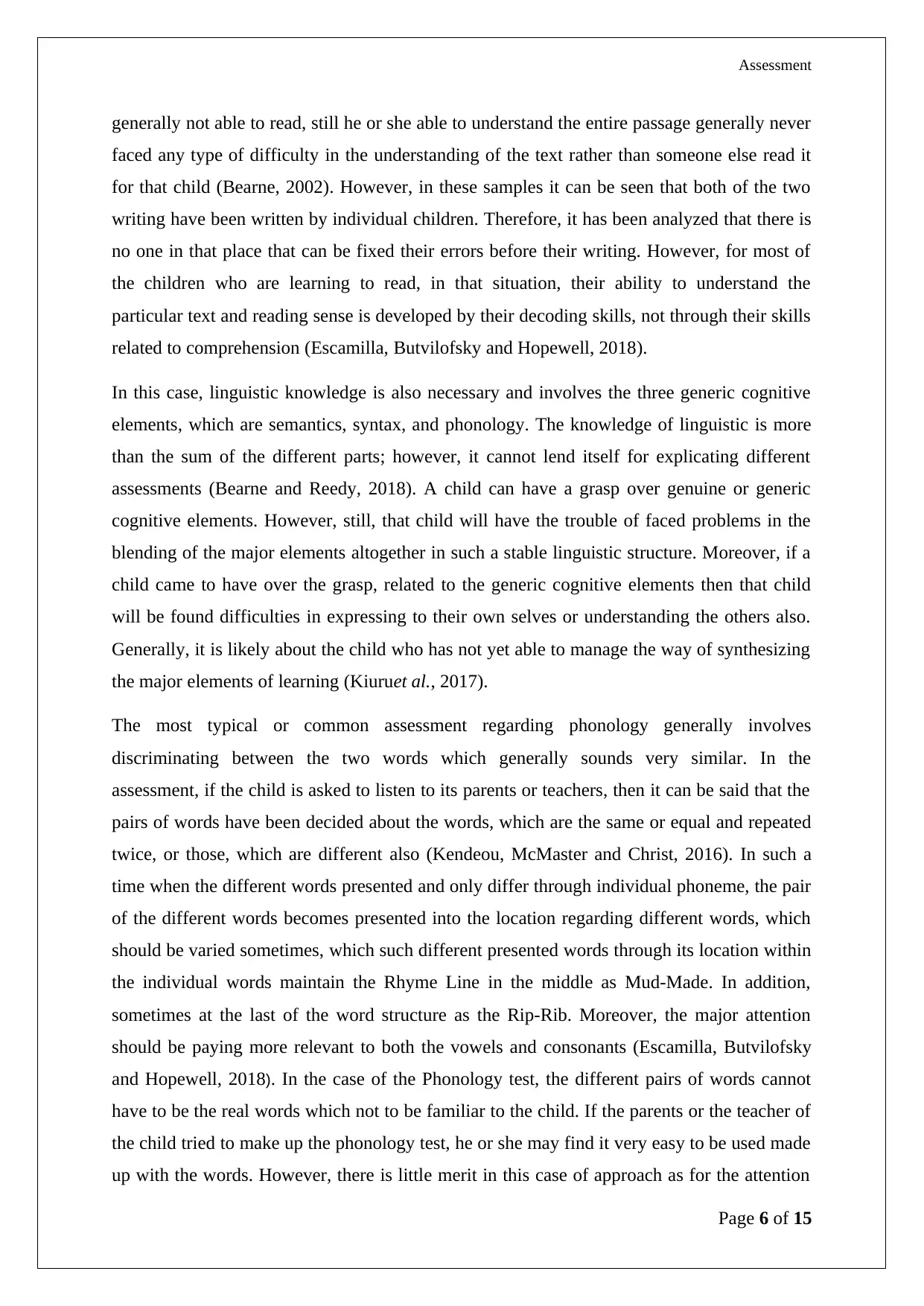
Assessment
generally not able to read, still he or she able to understand the entire passage generally never
faced any type of difficulty in the understanding of the text rather than someone else read it
for that child (Bearne, 2002). However, in these samples it can be seen that both of the two
writing have been written by individual children. Therefore, it has been analyzed that there is
no one in that place that can be fixed their errors before their writing. However, for most of
the children who are learning to read, in that situation, their ability to understand the
particular text and reading sense is developed by their decoding skills, not through their skills
related to comprehension (Escamilla, Butvilofsky and Hopewell, 2018).
In this case, linguistic knowledge is also necessary and involves the three generic cognitive
elements, which are semantics, syntax, and phonology. The knowledge of linguistic is more
than the sum of the different parts; however, it cannot lend itself for explicating different
assessments (Bearne and Reedy, 2018). A child can have a grasp over genuine or generic
cognitive elements. However, still, that child will have the trouble of faced problems in the
blending of the major elements altogether in such a stable linguistic structure. Moreover, if a
child came to have over the grasp, related to the generic cognitive elements then that child
will be found difficulties in expressing to their own selves or understanding the others also.
Generally, it is likely about the child who has not yet able to manage the way of synthesizing
the major elements of learning (Kiuruet al., 2017).
The most typical or common assessment regarding phonology generally involves
discriminating between the two words which generally sounds very similar. In the
assessment, if the child is asked to listen to its parents or teachers, then it can be said that the
pairs of words have been decided about the words, which are the same or equal and repeated
twice, or those, which are different also (Kendeou, McMaster and Christ, 2016). In such a
time when the different words presented and only differ through individual phoneme, the pair
of the different words becomes presented into the location regarding different words, which
should be varied sometimes, which such different presented words through its location within
the individual words maintain the Rhyme Line in the middle as Mud-Made. In addition,
sometimes at the last of the word structure as the Rip-Rib. Moreover, the major attention
should be paying more relevant to both the vowels and consonants (Escamilla, Butvilofsky
and Hopewell, 2018). In the case of the Phonology test, the different pairs of words cannot
have to be the real words which not to be familiar to the child. If the parents or the teacher of
the child tried to make up the phonology test, he or she may find it very easy to be used made
up with the words. However, there is little merit in this case of approach as for the attention
Page 6 of 15
generally not able to read, still he or she able to understand the entire passage generally never
faced any type of difficulty in the understanding of the text rather than someone else read it
for that child (Bearne, 2002). However, in these samples it can be seen that both of the two
writing have been written by individual children. Therefore, it has been analyzed that there is
no one in that place that can be fixed their errors before their writing. However, for most of
the children who are learning to read, in that situation, their ability to understand the
particular text and reading sense is developed by their decoding skills, not through their skills
related to comprehension (Escamilla, Butvilofsky and Hopewell, 2018).
In this case, linguistic knowledge is also necessary and involves the three generic cognitive
elements, which are semantics, syntax, and phonology. The knowledge of linguistic is more
than the sum of the different parts; however, it cannot lend itself for explicating different
assessments (Bearne and Reedy, 2018). A child can have a grasp over genuine or generic
cognitive elements. However, still, that child will have the trouble of faced problems in the
blending of the major elements altogether in such a stable linguistic structure. Moreover, if a
child came to have over the grasp, related to the generic cognitive elements then that child
will be found difficulties in expressing to their own selves or understanding the others also.
Generally, it is likely about the child who has not yet able to manage the way of synthesizing
the major elements of learning (Kiuruet al., 2017).
The most typical or common assessment regarding phonology generally involves
discriminating between the two words which generally sounds very similar. In the
assessment, if the child is asked to listen to its parents or teachers, then it can be said that the
pairs of words have been decided about the words, which are the same or equal and repeated
twice, or those, which are different also (Kendeou, McMaster and Christ, 2016). In such a
time when the different words presented and only differ through individual phoneme, the pair
of the different words becomes presented into the location regarding different words, which
should be varied sometimes, which such different presented words through its location within
the individual words maintain the Rhyme Line in the middle as Mud-Made. In addition,
sometimes at the last of the word structure as the Rip-Rib. Moreover, the major attention
should be paying more relevant to both the vowels and consonants (Escamilla, Butvilofsky
and Hopewell, 2018). In the case of the Phonology test, the different pairs of words cannot
have to be the real words which not to be familiar to the child. If the parents or the teacher of
the child tried to make up the phonology test, he or she may find it very easy to be used made
up with the words. However, there is little merit in this case of approach as for the attention
Page 6 of 15
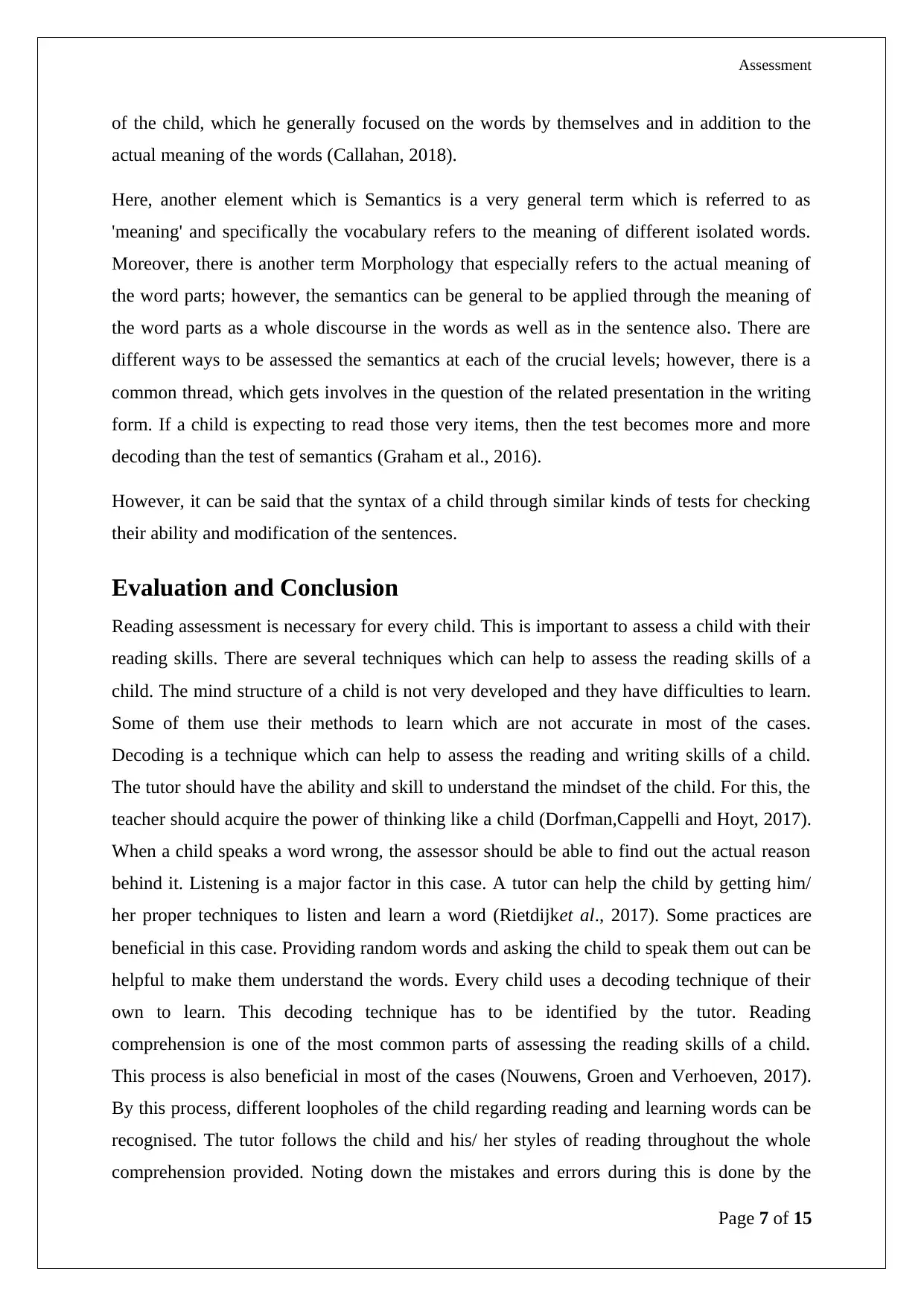
Assessment
of the child, which he generally focused on the words by themselves and in addition to the
actual meaning of the words (Callahan, 2018).
Here, another element which is Semantics is a very general term which is referred to as
'meaning' and specifically the vocabulary refers to the meaning of different isolated words.
Moreover, there is another term Morphology that especially refers to the actual meaning of
the word parts; however, the semantics can be general to be applied through the meaning of
the word parts as a whole discourse in the words as well as in the sentence also. There are
different ways to be assessed the semantics at each of the crucial levels; however, there is a
common thread, which gets involves in the question of the related presentation in the writing
form. If a child is expecting to read those very items, then the test becomes more and more
decoding than the test of semantics (Graham et al., 2016).
However, it can be said that the syntax of a child through similar kinds of tests for checking
their ability and modification of the sentences.
Evaluation and Conclusion
Reading assessment is necessary for every child. This is important to assess a child with their
reading skills. There are several techniques which can help to assess the reading skills of a
child. The mind structure of a child is not very developed and they have difficulties to learn.
Some of them use their methods to learn which are not accurate in most of the cases.
Decoding is a technique which can help to assess the reading and writing skills of a child.
The tutor should have the ability and skill to understand the mindset of the child. For this, the
teacher should acquire the power of thinking like a child (Dorfman,Cappelli and Hoyt, 2017).
When a child speaks a word wrong, the assessor should be able to find out the actual reason
behind it. Listening is a major factor in this case. A tutor can help the child by getting him/
her proper techniques to listen and learn a word (Rietdijket al., 2017). Some practices are
beneficial in this case. Providing random words and asking the child to speak them out can be
helpful to make them understand the words. Every child uses a decoding technique of their
own to learn. This decoding technique has to be identified by the tutor. Reading
comprehension is one of the most common parts of assessing the reading skills of a child.
This process is also beneficial in most of the cases (Nouwens, Groen and Verhoeven, 2017).
By this process, different loopholes of the child regarding reading and learning words can be
recognised. The tutor follows the child and his/ her styles of reading throughout the whole
comprehension provided. Noting down the mistakes and errors during this is done by the
Page 7 of 15
of the child, which he generally focused on the words by themselves and in addition to the
actual meaning of the words (Callahan, 2018).
Here, another element which is Semantics is a very general term which is referred to as
'meaning' and specifically the vocabulary refers to the meaning of different isolated words.
Moreover, there is another term Morphology that especially refers to the actual meaning of
the word parts; however, the semantics can be general to be applied through the meaning of
the word parts as a whole discourse in the words as well as in the sentence also. There are
different ways to be assessed the semantics at each of the crucial levels; however, there is a
common thread, which gets involves in the question of the related presentation in the writing
form. If a child is expecting to read those very items, then the test becomes more and more
decoding than the test of semantics (Graham et al., 2016).
However, it can be said that the syntax of a child through similar kinds of tests for checking
their ability and modification of the sentences.
Evaluation and Conclusion
Reading assessment is necessary for every child. This is important to assess a child with their
reading skills. There are several techniques which can help to assess the reading skills of a
child. The mind structure of a child is not very developed and they have difficulties to learn.
Some of them use their methods to learn which are not accurate in most of the cases.
Decoding is a technique which can help to assess the reading and writing skills of a child.
The tutor should have the ability and skill to understand the mindset of the child. For this, the
teacher should acquire the power of thinking like a child (Dorfman,Cappelli and Hoyt, 2017).
When a child speaks a word wrong, the assessor should be able to find out the actual reason
behind it. Listening is a major factor in this case. A tutor can help the child by getting him/
her proper techniques to listen and learn a word (Rietdijket al., 2017). Some practices are
beneficial in this case. Providing random words and asking the child to speak them out can be
helpful to make them understand the words. Every child uses a decoding technique of their
own to learn. This decoding technique has to be identified by the tutor. Reading
comprehension is one of the most common parts of assessing the reading skills of a child.
This process is also beneficial in most of the cases (Nouwens, Groen and Verhoeven, 2017).
By this process, different loopholes of the child regarding reading and learning words can be
recognised. The tutor follows the child and his/ her styles of reading throughout the whole
comprehension provided. Noting down the mistakes and errors during this is done by the
Page 7 of 15
Paraphrase This Document
Need a fresh take? Get an instant paraphrase of this document with our AI Paraphraser
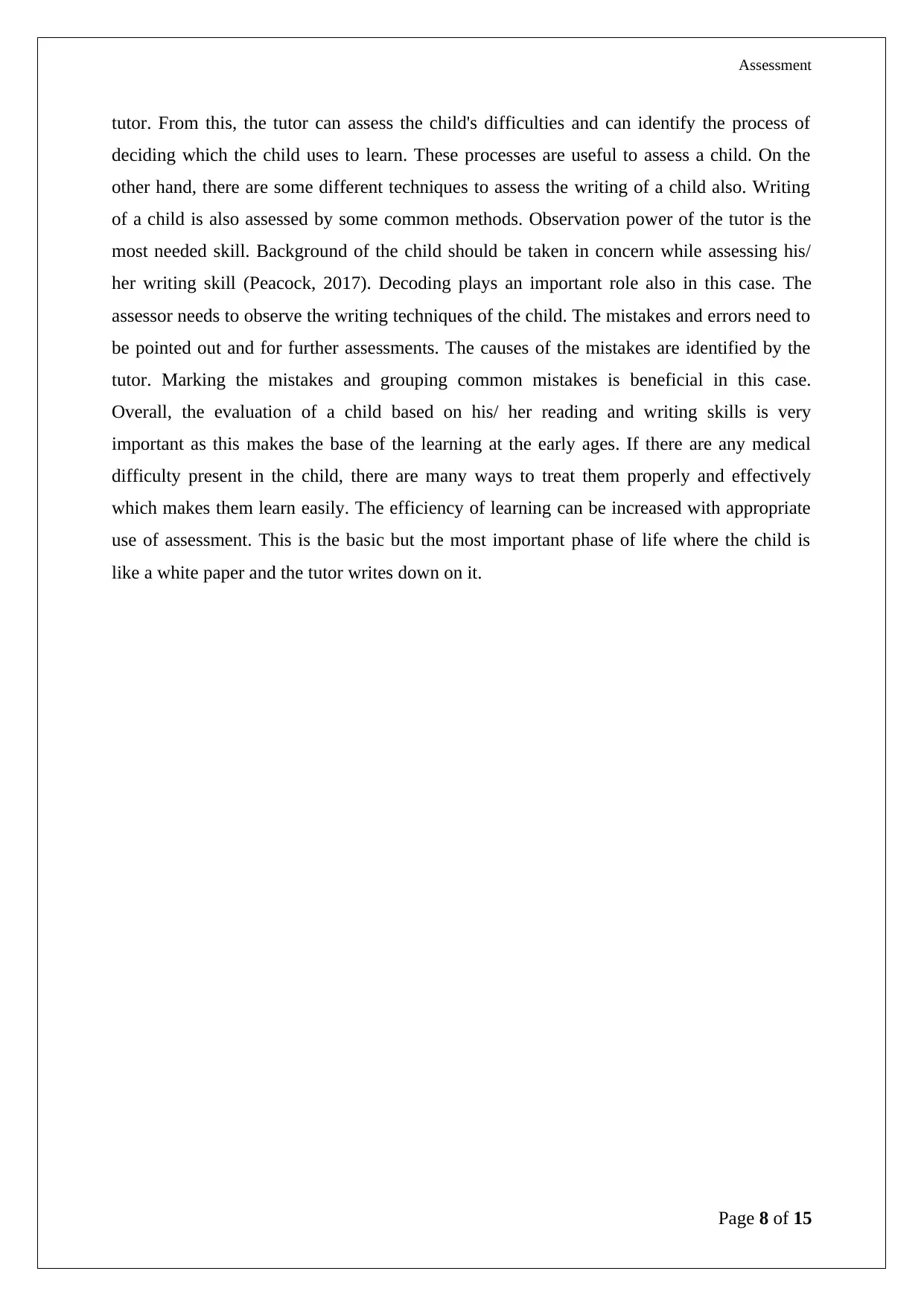
Assessment
tutor. From this, the tutor can assess the child's difficulties and can identify the process of
deciding which the child uses to learn. These processes are useful to assess a child. On the
other hand, there are some different techniques to assess the writing of a child also. Writing
of a child is also assessed by some common methods. Observation power of the tutor is the
most needed skill. Background of the child should be taken in concern while assessing his/
her writing skill (Peacock, 2017). Decoding plays an important role also in this case. The
assessor needs to observe the writing techniques of the child. The mistakes and errors need to
be pointed out and for further assessments. The causes of the mistakes are identified by the
tutor. Marking the mistakes and grouping common mistakes is beneficial in this case.
Overall, the evaluation of a child based on his/ her reading and writing skills is very
important as this makes the base of the learning at the early ages. If there are any medical
difficulty present in the child, there are many ways to treat them properly and effectively
which makes them learn easily. The efficiency of learning can be increased with appropriate
use of assessment. This is the basic but the most important phase of life where the child is
like a white paper and the tutor writes down on it.
Page 8 of 15
tutor. From this, the tutor can assess the child's difficulties and can identify the process of
deciding which the child uses to learn. These processes are useful to assess a child. On the
other hand, there are some different techniques to assess the writing of a child also. Writing
of a child is also assessed by some common methods. Observation power of the tutor is the
most needed skill. Background of the child should be taken in concern while assessing his/
her writing skill (Peacock, 2017). Decoding plays an important role also in this case. The
assessor needs to observe the writing techniques of the child. The mistakes and errors need to
be pointed out and for further assessments. The causes of the mistakes are identified by the
tutor. Marking the mistakes and grouping common mistakes is beneficial in this case.
Overall, the evaluation of a child based on his/ her reading and writing skills is very
important as this makes the base of the learning at the early ages. If there are any medical
difficulty present in the child, there are many ways to treat them properly and effectively
which makes them learn easily. The efficiency of learning can be increased with appropriate
use of assessment. This is the basic but the most important phase of life where the child is
like a white paper and the tutor writes down on it.
Page 8 of 15
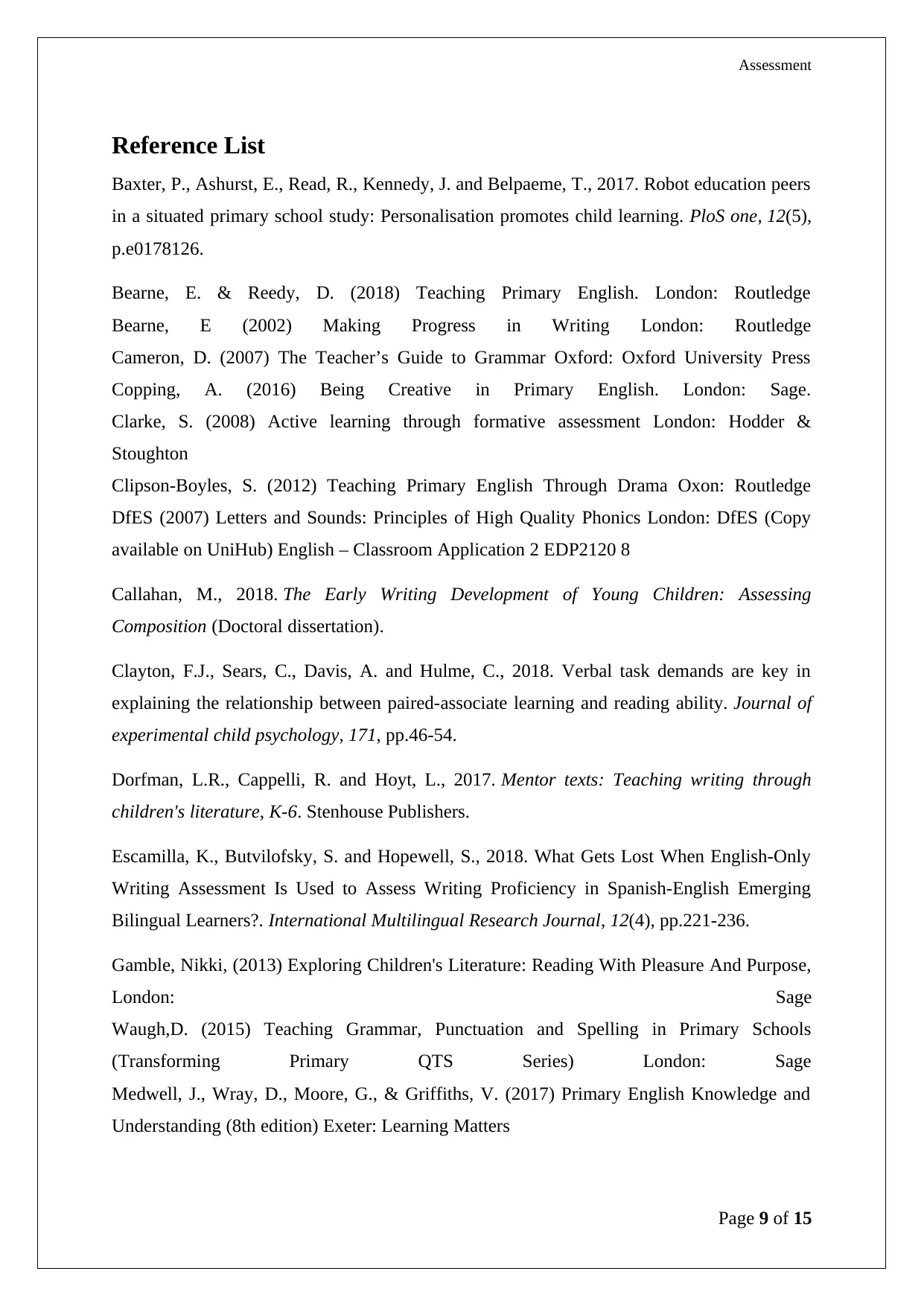
Assessment
Reference List
Baxter, P., Ashurst, E., Read, R., Kennedy, J. and Belpaeme, T., 2017. Robot education peers
in a situated primary school study: Personalisation promotes child learning. PloS one, 12(5),
p.e0178126.
Bearne, E. & Reedy, D. (2018) Teaching Primary English. London: Routledge
Bearne, E (2002) Making Progress in Writing London: Routledge
Cameron, D. (2007) The Teacher’s Guide to Grammar Oxford: Oxford University Press
Copping, A. (2016) Being Creative in Primary English. London: Sage.
Clarke, S. (2008) Active learning through formative assessment London: Hodder &
Stoughton
Clipson-Boyles, S. (2012) Teaching Primary English Through Drama Oxon: Routledge
DfES (2007) Letters and Sounds: Principles of High Quality Phonics London: DfES (Copy
available on UniHub) English – Classroom Application 2 EDP2120 8
Callahan, M., 2018. The Early Writing Development of Young Children: Assessing
Composition (Doctoral dissertation).
Clayton, F.J., Sears, C., Davis, A. and Hulme, C., 2018. Verbal task demands are key in
explaining the relationship between paired-associate learning and reading ability. Journal of
experimental child psychology, 171, pp.46-54.
Dorfman, L.R., Cappelli, R. and Hoyt, L., 2017. Mentor texts: Teaching writing through
children's literature, K-6. Stenhouse Publishers.
Escamilla, K., Butvilofsky, S. and Hopewell, S., 2018. What Gets Lost When English-Only
Writing Assessment Is Used to Assess Writing Proficiency in Spanish-English Emerging
Bilingual Learners?. International Multilingual Research Journal, 12(4), pp.221-236.
Gamble, Nikki, (2013) Exploring Children's Literature: Reading With Pleasure And Purpose,
London: Sage
Waugh,D. (2015) Teaching Grammar, Punctuation and Spelling in Primary Schools
(Transforming Primary QTS Series) London: Sage
Medwell, J., Wray, D., Moore, G., & Griffiths, V. (2017) Primary English Knowledge and
Understanding (8th edition) Exeter: Learning Matters
Page 9 of 15
Reference List
Baxter, P., Ashurst, E., Read, R., Kennedy, J. and Belpaeme, T., 2017. Robot education peers
in a situated primary school study: Personalisation promotes child learning. PloS one, 12(5),
p.e0178126.
Bearne, E. & Reedy, D. (2018) Teaching Primary English. London: Routledge
Bearne, E (2002) Making Progress in Writing London: Routledge
Cameron, D. (2007) The Teacher’s Guide to Grammar Oxford: Oxford University Press
Copping, A. (2016) Being Creative in Primary English. London: Sage.
Clarke, S. (2008) Active learning through formative assessment London: Hodder &
Stoughton
Clipson-Boyles, S. (2012) Teaching Primary English Through Drama Oxon: Routledge
DfES (2007) Letters and Sounds: Principles of High Quality Phonics London: DfES (Copy
available on UniHub) English – Classroom Application 2 EDP2120 8
Callahan, M., 2018. The Early Writing Development of Young Children: Assessing
Composition (Doctoral dissertation).
Clayton, F.J., Sears, C., Davis, A. and Hulme, C., 2018. Verbal task demands are key in
explaining the relationship between paired-associate learning and reading ability. Journal of
experimental child psychology, 171, pp.46-54.
Dorfman, L.R., Cappelli, R. and Hoyt, L., 2017. Mentor texts: Teaching writing through
children's literature, K-6. Stenhouse Publishers.
Escamilla, K., Butvilofsky, S. and Hopewell, S., 2018. What Gets Lost When English-Only
Writing Assessment Is Used to Assess Writing Proficiency in Spanish-English Emerging
Bilingual Learners?. International Multilingual Research Journal, 12(4), pp.221-236.
Gamble, Nikki, (2013) Exploring Children's Literature: Reading With Pleasure And Purpose,
London: Sage
Waugh,D. (2015) Teaching Grammar, Punctuation and Spelling in Primary Schools
(Transforming Primary QTS Series) London: Sage
Medwell, J., Wray, D., Moore, G., & Griffiths, V. (2017) Primary English Knowledge and
Understanding (8th edition) Exeter: Learning Matters
Page 9 of 15

Assessment
Graham, S., Hebert, M., Paige Sandbank, M. and Harris, K.R., 2016. Assessing the writing
achievement of young struggling writers: Application of generalizability theory. Learning
Disability Quarterly, 39(2), pp.72-82.
Kendeou, P., McMaster, K.L. and Christ, T.J., 2016. Reading comprehension: Core
components and processes. Policy Insights from the Behavioral and Brain Sciences, 3(1),
pp.62-69.
Kiuru, N., DeLay, D., Laursen, B., Burk, W.J., Lerkkanen, M.K., Poikkeus, A.M. and Nurmi,
J.E., 2017. Peer selection and influence on children’s reading skills in early primary grades: a
social network approach. Reading and Writing, 30(7), pp.1473-1500.
Mennella, J.A. and Bobowski, N.K., 2016. Psychophysical tracking method to measure taste
preferences in children and adults. JoVE (Journal of Visualized Experiments), (113),
p.e54163.
Nouwens, S., Groen, M.A. and Verhoeven, L., 2017. How working memory relates to
children’s reading comprehension: the importance of domain-specificity in storage and
processing. Reading and writing, 30(1), pp.105-120.
Peacock, C., 2017. Teaching writing: a systematic approach. Routledge.
Perfetti, C.A., 2017. Cognitive and linguistic components of reading ability. In Acquisition of
Reading Skills (1986) (pp. 11-40). Routledge.
Rietdijk, S., Janssen, T., van Weijen, D., van den Bergh, H. and Rijlaarsdam, G., 2017.
Improving writing in primary schools through a comprehensive writing program. The Journal
of Writing Research, 9(2), pp.173-225.
Rothou, K.M. and Tsimpli, I., 2017. Biliteracy and reading ability in children who learn
Greek as a second language. International Journal of Bilingual Education and Bilingualism,
pp.1-15.
Swagerman, S.C., Van Bergen, E., Dolan, C., de Geus, E.J., Koenis, M.M., Pol, H.E.H. and
Boomsma, D.I., 2017. Genetic transmission of reading ability. Brain and Language, 172,
pp.3-8.
Tobia, V., Ciancaleoni, M. and Bonifacci, P., 2017. Theoretical models of comprehension
skills tested through a comprehension assessment battery for primary school
children. Language Testing, 34(2), pp.223-239.
Page 10 of 15
Graham, S., Hebert, M., Paige Sandbank, M. and Harris, K.R., 2016. Assessing the writing
achievement of young struggling writers: Application of generalizability theory. Learning
Disability Quarterly, 39(2), pp.72-82.
Kendeou, P., McMaster, K.L. and Christ, T.J., 2016. Reading comprehension: Core
components and processes. Policy Insights from the Behavioral and Brain Sciences, 3(1),
pp.62-69.
Kiuru, N., DeLay, D., Laursen, B., Burk, W.J., Lerkkanen, M.K., Poikkeus, A.M. and Nurmi,
J.E., 2017. Peer selection and influence on children’s reading skills in early primary grades: a
social network approach. Reading and Writing, 30(7), pp.1473-1500.
Mennella, J.A. and Bobowski, N.K., 2016. Psychophysical tracking method to measure taste
preferences in children and adults. JoVE (Journal of Visualized Experiments), (113),
p.e54163.
Nouwens, S., Groen, M.A. and Verhoeven, L., 2017. How working memory relates to
children’s reading comprehension: the importance of domain-specificity in storage and
processing. Reading and writing, 30(1), pp.105-120.
Peacock, C., 2017. Teaching writing: a systematic approach. Routledge.
Perfetti, C.A., 2017. Cognitive and linguistic components of reading ability. In Acquisition of
Reading Skills (1986) (pp. 11-40). Routledge.
Rietdijk, S., Janssen, T., van Weijen, D., van den Bergh, H. and Rijlaarsdam, G., 2017.
Improving writing in primary schools through a comprehensive writing program. The Journal
of Writing Research, 9(2), pp.173-225.
Rothou, K.M. and Tsimpli, I., 2017. Biliteracy and reading ability in children who learn
Greek as a second language. International Journal of Bilingual Education and Bilingualism,
pp.1-15.
Swagerman, S.C., Van Bergen, E., Dolan, C., de Geus, E.J., Koenis, M.M., Pol, H.E.H. and
Boomsma, D.I., 2017. Genetic transmission of reading ability. Brain and Language, 172,
pp.3-8.
Tobia, V., Ciancaleoni, M. and Bonifacci, P., 2017. Theoretical models of comprehension
skills tested through a comprehension assessment battery for primary school
children. Language Testing, 34(2), pp.223-239.
Page 10 of 15
Secure Best Marks with AI Grader
Need help grading? Try our AI Grader for instant feedback on your assignments.

Assessment
Tse, L.F.L., Siu, A.M.H. and Li-Tsang, C.W.P., 2019. Assessment of early handwriting skill
in kindergarten children using a Chinese name writing test. Reading and Writing, 32(2),
pp.265-284.
Vukelich, C., Enz, B., Roskos, K.A. and Kristie, J., 2019. Helping young children learn
language and literacy: Birth through kindergarten.
Zajic, M.C., McIntyre, N., Swain-Lerro, L., Novotny, S., Oswald, T. and Mundy, P., 2018.
Attention and written expression in school-age, high-functioning children with autism
spectrum disorders. Autism, 22(3), pp.245-258.
Page 11 of 15
Tse, L.F.L., Siu, A.M.H. and Li-Tsang, C.W.P., 2019. Assessment of early handwriting skill
in kindergarten children using a Chinese name writing test. Reading and Writing, 32(2),
pp.265-284.
Vukelich, C., Enz, B., Roskos, K.A. and Kristie, J., 2019. Helping young children learn
language and literacy: Birth through kindergarten.
Zajic, M.C., McIntyre, N., Swain-Lerro, L., Novotny, S., Oswald, T. and Mundy, P., 2018.
Attention and written expression in school-age, high-functioning children with autism
spectrum disorders. Autism, 22(3), pp.245-258.
Page 11 of 15
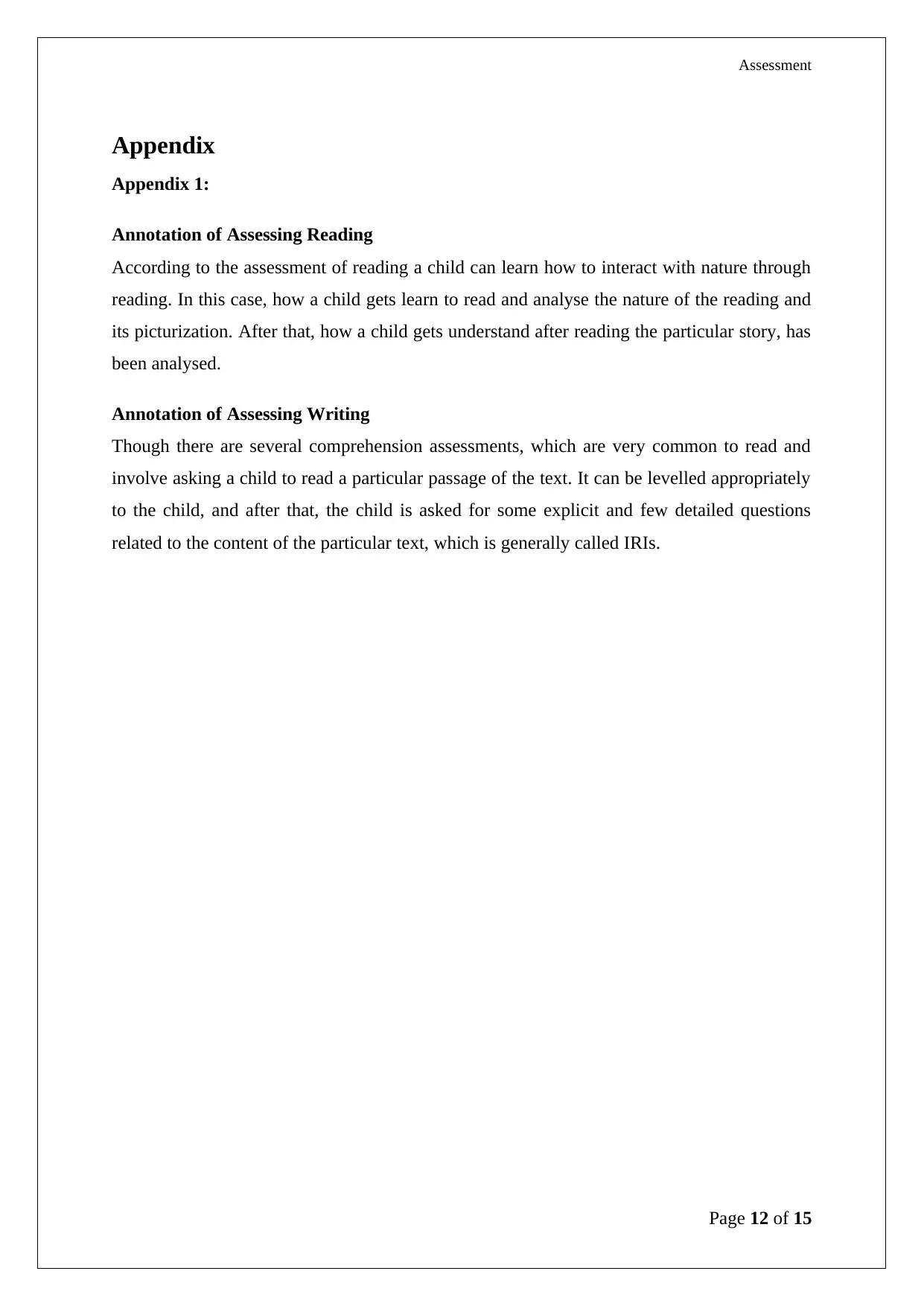
Assessment
Appendix
Appendix 1:
Annotation of Assessing Reading
According to the assessment of reading a child can learn how to interact with nature through
reading. In this case, how a child gets learn to read and analyse the nature of the reading and
its picturization. After that, how a child gets understand after reading the particular story, has
been analysed.
Annotation of Assessing Writing
Though there are several comprehension assessments, which are very common to read and
involve asking a child to read a particular passage of the text. It can be levelled appropriately
to the child, and after that, the child is asked for some explicit and few detailed questions
related to the content of the particular text, which is generally called IRIs.
Page 12 of 15
Appendix
Appendix 1:
Annotation of Assessing Reading
According to the assessment of reading a child can learn how to interact with nature through
reading. In this case, how a child gets learn to read and analyse the nature of the reading and
its picturization. After that, how a child gets understand after reading the particular story, has
been analysed.
Annotation of Assessing Writing
Though there are several comprehension assessments, which are very common to read and
involve asking a child to read a particular passage of the text. It can be levelled appropriately
to the child, and after that, the child is asked for some explicit and few detailed questions
related to the content of the particular text, which is generally called IRIs.
Page 12 of 15
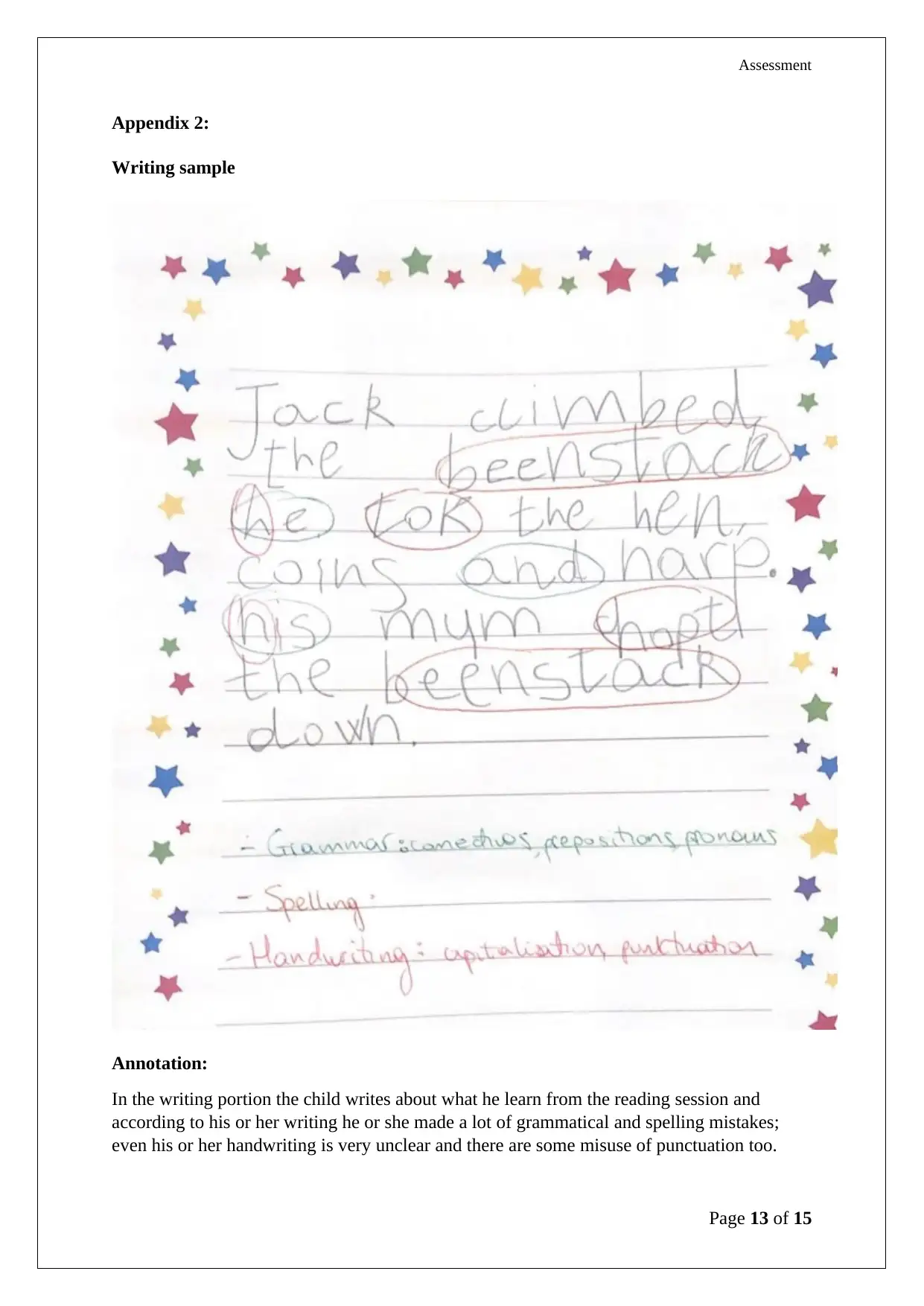
Assessment
Appendix 2:
Writing sample
Annotation:
In the writing portion the child writes about what he learn from the reading session and
according to his or her writing he or she made a lot of grammatical and spelling mistakes;
even his or her handwriting is very unclear and there are some misuse of punctuation too.
Page 13 of 15
Appendix 2:
Writing sample
Annotation:
In the writing portion the child writes about what he learn from the reading session and
according to his or her writing he or she made a lot of grammatical and spelling mistakes;
even his or her handwriting is very unclear and there are some misuse of punctuation too.
Page 13 of 15
Paraphrase This Document
Need a fresh take? Get an instant paraphrase of this document with our AI Paraphraser
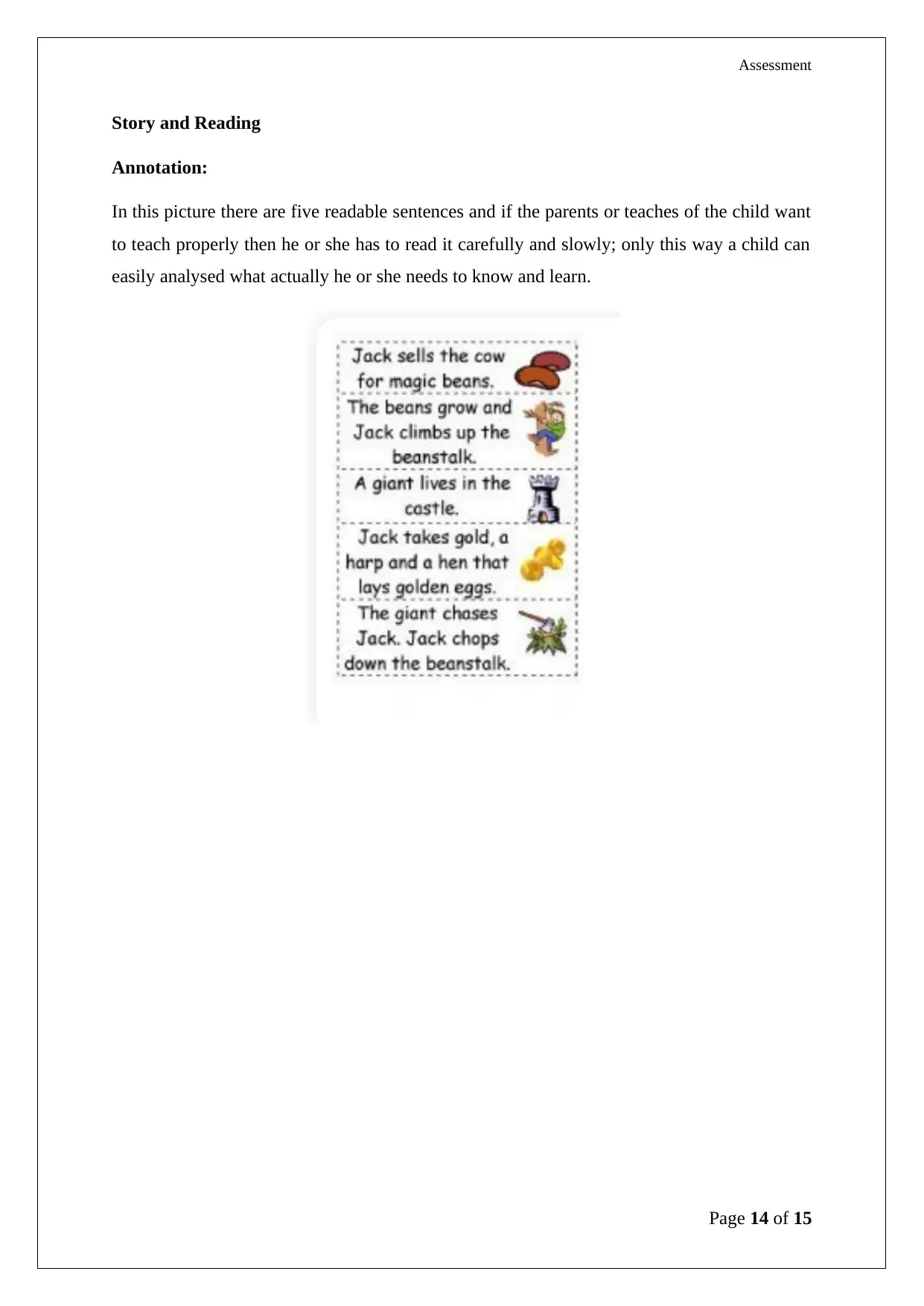
Assessment
Story and Reading
Annotation:
In this picture there are five readable sentences and if the parents or teaches of the child want
to teach properly then he or she has to read it carefully and slowly; only this way a child can
easily analysed what actually he or she needs to know and learn.
Page 14 of 15
Story and Reading
Annotation:
In this picture there are five readable sentences and if the parents or teaches of the child want
to teach properly then he or she has to read it carefully and slowly; only this way a child can
easily analysed what actually he or she needs to know and learn.
Page 14 of 15

Assessment
Appendix 3: Comprehension questions and answers
Questions Responses
What do you think about the cover picture? It is colourful. I like the picture
What is most interesting in this story? Seed and long tree
Would you like to play the role of jack? No
Who is your favourite character in this? Jack
Do you like this story? Yes
Would to like to get a seed like this? I have to ask my mother about this
Annotation:
Here it has been showed six different questions and the answers given by the child which are
quite interesting and enough to understand that does the child analyse properly or not.
Page 15 of 15
Appendix 3: Comprehension questions and answers
Questions Responses
What do you think about the cover picture? It is colourful. I like the picture
What is most interesting in this story? Seed and long tree
Would you like to play the role of jack? No
Who is your favourite character in this? Jack
Do you like this story? Yes
Would to like to get a seed like this? I have to ask my mother about this
Annotation:
Here it has been showed six different questions and the answers given by the child which are
quite interesting and enough to understand that does the child analyse properly or not.
Page 15 of 15
1 out of 15
Your All-in-One AI-Powered Toolkit for Academic Success.
+13062052269
info@desklib.com
Available 24*7 on WhatsApp / Email
![[object Object]](/_next/static/media/star-bottom.7253800d.svg)
Unlock your academic potential
© 2024 | Zucol Services PVT LTD | All rights reserved.


